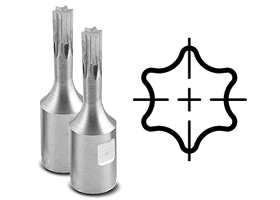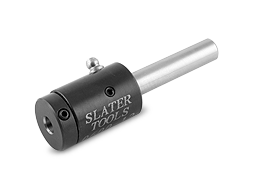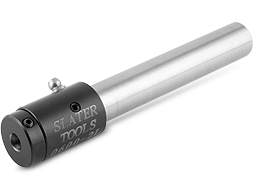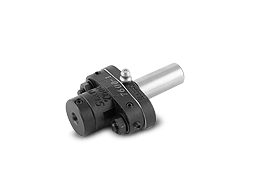
Six Lobe Broaches
Slater Tools Inc. offers the largest variety of internal Six Lobe Rotary Broach Tools, also known as Torx-like or hexalobular Rotary Broaches. Most standard size Six Lobe Torx-like Rotary Broach Tools are in stock, available for immediate delivery. Six Lobe Rotary Broaches conform with ISO 10664 and can be produced in special sizes and custom lengths. They can also be made in a variety of materials and coatings. Vent holes, quantity discounts and resharpening are available.
DIAMETER: .315" Shank Diameter

1.25 OVERALL LENGTH
| T Size | B | Part # |
|---|---|---|
| T6 Six Lobe Broach | .0703 | 308-06 |
| T7 Six Lobe Broach | .0827 | 308-07 |
| T8 Six Lobe Broach | .0954 | 308-08 |
| T9 Six Lobe Broach | .1028 | 308-09 |
| T10 Six Lobe Broach | .1123 | 308-10 |
| T15 Six Lobe Broach | .1333 | 308-15 |
| T20 Six Lobe Broach | .1563 | 308-20 |
| T25 Six Lobe Broach | .1798 | 308-25 |
1.75 OVERALL LENGTH
| T Size | B | Part # |
|---|---|---|
| T10 Six Lobe Broach | .1123 | 348-10 |
| T15 Six Lobe Broach | .1333 | 348-15 |
| T20 Six Lobe Broach | .1563 | 348-20 |
| T25 Six Lobe Broach | .1798 | 348-25 |
| T27 Six Lobe Broach | .2018 | 348-27 |
COATING OPTIONS
Titanium Nitride (TiN)
TiN is a gold colored PVD coating made of exceptionally hard ceramic material that improves lubricity, increases hardness and enhances abrasive wear resistance leading to increased broach tool life.
Titanium Carbonitride (TiCN)
TiCN is a purple-gray colored PVD coating formed by the addition of carbon to the TiN formula. The elevated hardness and low residual stress lead to excellent abrasive wear resistance. TiCN coating also increases lubricity of the broach and performs well under high load conditions. TiCN is commonly used in medical and aerospace applications broaching small forms in stainless steel and titanium materials.
Titanium Aluminum Nitride (TiAIN)
TiAlN is a dark gray colored PVD coating that can be used in high temperature conditions and for better lubricity. Harder than TiN, TiAlN has excellent abrasive wear resistance and is used successfully to broach many materials such as titanium, aluminum, stainless steels, and alloy steels.
MATERIAL OPTIONS
M2 High Speed Steel
M2 is a molybdenum based high speed steel that is characterized by abrasion resistance, toughness and good red hardness. Slater Tools' hardened M2 broaches have an ideal balance of bending strength, toughness and wear resistance. M2 is used in a wide range of rotary broaching applications and is suitable for any broachable material.
PM M4 High Speed Steel
PM M4 is a molybdenum-tungsten high speed steel, which is produced with a very consistent and refined structure. This structure gives PM M4 broaches several enhanced properties including improved toughness and better wear resistance. This material is good for stainless steel and titanium applications for decreased wear.
T15 High Speed Steel
PMT15 is a high-carbon tungsten-cobalt-vanadium high speed steel, composed of very fine grain structures. T15 has excellent red hardness and abrasion resistance. Like the PM M4, the structure of PM T15 broaches improves toughness and is a good choice for improving overall broach tool life.
OTHER CUSTOM OPTIONS
- Custom Overall Lengths Available (including 28mm)
- Custom Cut Lengths Available
- MICRO forms
- Single or Double Vent Holes
- Flat on shank can be aligned with form (for holding orientation)
INTERNAL BROACHING PART PREPARATION
Pre-Drill Hole Diameter:
- A pre-drill hole is required for internal broaching.
- The pre-drill hole must be at least equal to the minor diameter of the broach. It is strongly recommended to open the hole diameter larger than the minor diameter.
- See below formulas for recommended pre-drill hole diameters of hex and square forms.

Pre-Drill Hole Depth:
- The depth of the pre-drill hole must be greater than the broaching depth to allow for chips to accumulate and avoid excess packing.
- If chips must be removed after broaching, it can be done with a drill or boring tool. A recess at the bottom of the pre-drill will allow the chips to break cleanly. The recess diameter should be larger than the major diameter of the broach.
- It is recommended to have a pre-drill depth of 1.75 x depth of broached area.

Lead Chamfer:
- A 45° lead chamfer must be provided for successful internal rotary broaching, going from the major diameter to the minor diameter of the form.

SPEEDS AND FEEDS
Speeds and feed rates for rotary broaching will depend on the material you are broaching and size form. Please refer to the Slater Tools Speeds and Feeds Chart.
 Close
Menu
Close
Menu


